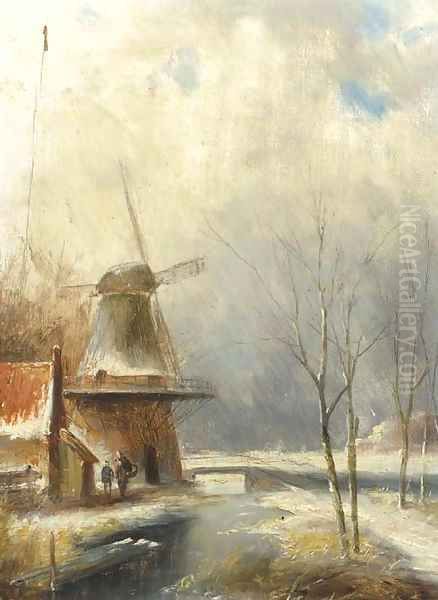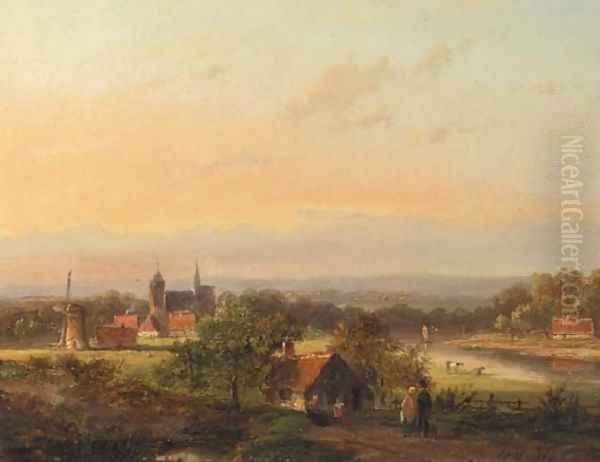Jan Evert Morel stands as a notable figure in the landscape of 19th-century Dutch art. Born in 1835, his life spanned a period of significant artistic development in the Netherlands. Primarily recognized as a landscape painter, Morel dedicated his career to capturing the serene beauty of nature, particularly the wooded environments of his homeland. His work reflects the prevailing artistic currents of his time, blending romantic sensibilities with a foundation in classical technique.
Living and working predominantly in Amsterdam, Morel became an active participant in the Dutch art scene. His artistic lineage connects him directly to his father, C. J. Morel, a painter known for his marine subjects. However, Jan Evert chose a different path, focusing his artistic vision on terrestrial scenes, especially forests. His development was also shaped by influential figures within Dutch art, most notably the celebrated landscape painter Bernard Cornelis Koekkoek. Morel passed away in Weesp in 1905, leaving behind a body of work appreciated for its detail and atmospheric quality.
Early Life and Artistic Formation
Jan Evert Morel entered the world in 1835, destined to follow an artistic path. His initial training came under the guidance of his father, C. J. Morel. The elder Morel was an established marine painter, skilled in depicting seascapes and maritime life. This familial connection provided Jan Evert with a foundational understanding of painting techniques and the artistic profession from an early age.
Despite his father's focus on the sea, Jan Evert Morel developed a distinct preference for landscape painting, particularly the depiction of forests and woodlands. This thematic divergence marked the beginning of his unique artistic identity. He spent a significant portion of his life based in the vibrant city of Amsterdam, which served as a hub for artists and cultural exchange during the 19th century. It was from this base that he developed his craft and engaged with the contemporary art world.

Morel's active period included regular exhibitions of his work, primarily between the years 1853 and 1874. These showings allowed him to present his evolving style and subject matter to the public and fellow artists, establishing his presence within the Dutch art community. His formative years were thus characterized by familial instruction, a deliberate choice of subject matter distinct from his father's, and engagement with the artistic center of Amsterdam.
Artistic Style and Influences
Jan Evert Morel's artistic style is characterized by a harmonious blend of Romantic emotional depth and classical technical precision. His paintings often evoke a sense of tranquility and poetic charm, capturing quiet moments within the natural world. He possessed a keen eye for detail, rendering trees, foliage, and atmospheric effects with considerable skill.
A recurring feature in Morel's work is the depiction of lush, brightly lit trees set against expansive, often brilliant blue skies. His landscapes are rarely empty; they frequently include small figures engaged in simple, everyday activities – peasants chatting by a path, solitary figures strolling near a riverbank – adding a human element to the serene natural settings. These elements contribute to the idyllic and peaceful mood that permeates much of his oeuvre.
The influence of Bernard Cornelis Koekkoek (1803-1862), a leading figure in Dutch Romantic landscape painting, is evident in Morel's work. Koekkoek was renowned for his meticulously crafted, often Italianate landscapes, which combined grandeur with fine detail. While Morel adopted Koekkoek's dedication to detail and romantic sensibility, his focus remained primarily on Dutch woodland scenes rather than the more idealized, southern European vistas favored by Koekkoek at times.
Morel typically worked on a smaller scale, favoring panel paintings. This format lent itself well to the intimate and detailed nature of his compositions. His ability to infuse these smaller works with both romantic feeling and classical structure distinguishes his contribution to 19th-century Dutch landscape painting. He navigated the line between observed reality and romantic idealization, creating works that were both believable and emotionally resonant.
Key Themes and Representative Works
The predominant theme in Jan Evert Morel's art is the Dutch landscape, with a particular emphasis on forest interiors and rural scenery. His paintings celebrate the quiet beauty of the countryside, often focusing on the interplay of light and shadow among trees, the textures of bark and foliage, and the gentle presence of water or pathways. His work captures a specific vision of the 19th-century Dutch environment, imbued with a sense of peace and nostalgia.

Several works exemplify Morel's style and thematic concerns. One such painting is A Winter Landscape with Peasants conversing by a Windmill. Created in the 19th century, this small panel (21.5 x 16 cm) depicts a characteristic Dutch winter scene, complete with a windmill and figures, showcasing his ability to capture seasonal atmosphere and human interaction within the landscape. This work is held in a private collection.
Another representative piece is Skaters on a frozen pond. Also dating from the 19th century and measuring 35.5 x 43.2 cm, this painting captures a lively winter activity, again demonstrating Morel's interest in genre elements within his landscapes. The scene likely portrays the communal aspect of Dutch winter life, set against a backdrop of carefully rendered natural details.
Interestingly, a work titled Stilleven met bloemen en fruit (Still life with flowers and fruit) is also associated with Morel. According to records, this piece dates from 1800-1808, which precedes Jan Evert Morel's birth. This suggests a possible attribution anomaly or confusion with another artist, perhaps an earlier family member, though the source material links it to him. This work, measuring 31 x 27 cm, is housed in the Rijksmuseum in Amsterdam. If indeed connected to the Morel family, it highlights a broader artistic engagement beyond landscapes.
Morel's Panoramic Landscape, created sometime during his working life (1835-1905), offers a broader view, depicting scenery related to Amsterdam and Weesp. This work (27.5 x 44 cm), held in a private collection, demonstrates his capacity for capturing wider vistas while maintaining his characteristic attention to detail. Another known work, A Dutch Town by a River, further illustrates his engagement with typical Dutch settings, combining landscape elements with architectural features.
The Artist in Context: Contemporaries and the Art Market
Jan Evert Morel operated within a rich artistic milieu in the 19th-century Netherlands. His most significant artistic connection was the influence exerted by Bernard Cornelis Koekkoek. Koekkoek was not merely an influence but the preeminent landscape painter of Dutch Romanticism, often called the "Prince of Landscape Painting." His success was immense, leading to challenges such as the emergence of forgeries, which prompted Koekkoek himself to issue certificates of authenticity starting in 1847.
Koekkoek's prominence is further highlighted by his prestigious commissions, such as those from King William II of the Netherlands. In 1845, the King invited Koekkoek to Luxembourg to paint landscapes, resulting in works like the depiction of Larochette Castle. These paintings exemplified the Romantic idealization of nature combined with meticulous execution that Koekkoek championed. His works commanded high prices, with pieces like Winter Landscape with Wood Gatherers fetching over a million euros at auction in the 21st century. Morel worked in the shadow of this towering figure, absorbing aspects of his style while carving his own niche.
While Morel was influenced by Koekkoek, the available information does not indicate direct collaboration or documented rivalry between them, or indeed with many other specific contemporaries. His father, C. J. Morel, was naturally a key figure in his early life, though their artistic paths diverged. Other painters active in Amsterdam during Morel's time included figures like the still-life painter Jacobus Linthorst (1745-1815), though Linthorst belonged to an earlier generation, a possible family connection is noted in the source material. Maria Margrita van Os (1779-1862), another still life painter, was also a contemporary figure in the broader Dutch art scene. Morel's primary interactions seem to have been through exhibitions (1853-1874) and his engagement with the art market.
Morel played an active role in the art trade beyond creating his own works. He was involved in supplying works by Dutch and Flemish Old Masters to collectors, including those in Denmark, utilizing the infrastructure of Amsterdam's auction houses. This activity suggests a practical engagement with the art market and likely brought him into contact with dealers, collectors, and potentially other artists, although specific details of these interactions remain scarce in the provided sources. His context was thus one defined by the towering influence of Koekkoek, familial artistic roots, and active participation in the Amsterdam art market.
Exhibitions and Collections
Jan Evert Morel's work gained visibility through various exhibitions during his lifetime and posthumously. His paintings were featured in shows that highlighted Dutch Romantic art and landscape painting. Records indicate several specific exhibitions where his works were displayed, showcasing his art to audiences in the Netherlands and beyond.
Between October 2010 and September 2013, Morel's art was part of an exhibition at the State Trofimov Museum in St. Petersburg, Russia. In 2014, his work was shown in The Hague as part of the Godeberta exhibition. That same year, his Panoramic Landscape was included in the exhibition "Romantic Journey: A Masterpiece from the Rademakers Collection" held in Eindhoven, likely at the Stedelijk Van Abbemuseum, which hosted the event.
International exposure continued in 2015. From January to April, his paintings were featured in the "Hommes et paysages" (Men and Landscapes) exhibition at the Musée National d'Histoire et d'Art (as inferred from the context, though the source mentions Musée National d'Art Moderne) in Luxembourg. Later that year, works by Morel were also part of an exhibition with the same title, "Hommes et paysages," held in Prague.
The enduring appeal of Morel's work is reflected in its presence in significant public collections. The prestigious Rijksmuseum in Amsterdam holds examples of his art, including the aforementioned still life Stilleven met bloemen en fruit. His works are also found in international collections, such as the State Trofimov Museum in St. Petersburg. The source material also mentions collections at the Royal Museums of Fine Arts of Belgium in Brussels and the Gemeentemuseum (likely referring to a museum in Brussels, as contextualized by the source, though the name is strongly associated with The Hague).
Beyond public institutions, Morel's paintings are held in numerous private collections. Their appearance at auctions, such as those held by Phillips in London and other private sales, attests to their continued circulation and value within the art market. This distribution across museums and private hands underscores the recognition Morel achieved as a skilled painter of the Dutch landscape.
Later Life and Legacy
Jan Evert Morel concluded his life and career in Weesp, a town near Amsterdam, where he passed away in 1905 at the age of 70. By the end of his life, he had established himself as a respected painter within the tradition of Dutch landscape art, contributing significantly to the Romantic movement in his country.
His legacy is primarily defined by his sensitive and detailed depictions of Dutch woodlands and rural scenes. Morel successfully captured the specific atmosphere and light of his native environment, creating works that resonate with a sense of peace and natural beauty. His adherence to careful technique, likely instilled during his early training and reinforced by the example of artists like Bernard Cornelis Koekkoek, ensured a high level of craftsmanship in his paintings.
The blend of Romanticism's emotional expression with the clarity and structure derived from classical traditions gives Morel's work a distinct quality. He offered viewers intimate glimpses into serene natural settings, often populated by subtly integrated figures that enhance the narrative and scale of the scene. His preference for smaller panels further emphasizes this intimacy.
Posthumously, Jan Evert Morel's reputation has endured. The inclusion of his works in major museum collections, such as the Rijksmuseum and international institutions, confirms his status within Dutch art history. His paintings continue to be appreciated by collectors and scholars for their technical skill, charming subject matter, and representation of 19th-century Dutch Romantic landscape painting. His art remains a testament to the enduring appeal of the Dutch countryside and the artistic traditions dedicated to capturing its essence.